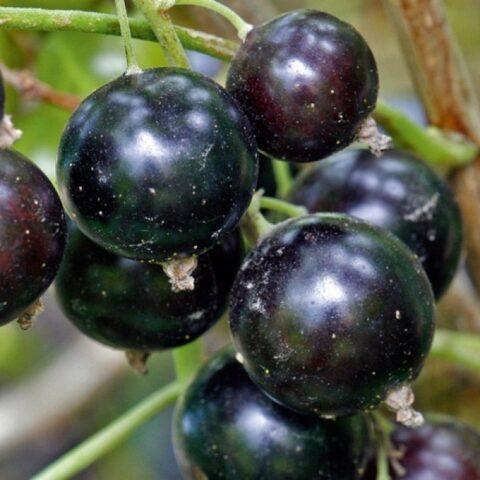Content
Black currant Galinka is a domestic variety, bred several decades ago. It produces a harvest of large, sweet and sour berries. The culture is unpretentious, survives frost and drought well, and is immune to some diseases and pests.
Breeding history
Galinka black currant appeared in 1980. Its breeding was carried out by employees of the Research Institute of Horticulture of Siberia named after M.A.Lisavenko - Zotov Z.S., Pershina M.A., Nazaryuk N.I., Shevkunova V.S., Teslya I.L.To obtain a new variety, Lepaan Musta was crossed and Seedling Dove. They also served as the basis for several more varieties of black currant.
Galinka was included in the State Register in 2001. According to the test results, it is approved for growing in the East Siberian and West Siberian regions.
Description of the variety of black currant Galinka
Galinka currant forms bushes of medium height, spreading and density. Their shoot-regenerating ability is weak. The buds of this variety are brown, devoid of pubescence. They are large, oblong with a blunt end.
The thickness of the growing shoots in the Galinka variety is medium, the color is matte, light green. They are weakly curved, no pubescence. After lignification, the color becomes light brown.
The black currant Galinka has five-lobed leaves of large and medium size. They have a matte, light green color, a leathery wrinkled surface and concave plates. The tops of the blades are pointed. There are narrow, deep and slightly open grooves at the base of the leaves. The teeth are short and sharp, with a distinct hooked tip. The petioles are of medium length and thickness, the coloration is green, weak at the edges. The leaves of this variety have well-developed basal lobes. Their veins are directed to the petiole.
Characteristics of Galinka berries:
- large size;
- weight 2-4 g;
- round shape;
- the color is black;
- the skin is shiny;
- dry separation;
- the number of seeds is average.
The content of soluble dry substances in the fruits of black currant Galinka is about 4.5%, pectin 1-1.5%, sugars 7.5-9.5%. The titratable acidity of the berries is 2.2-3%. 100 g of fruit accounts for up to 200 mg of ascorbic acid.
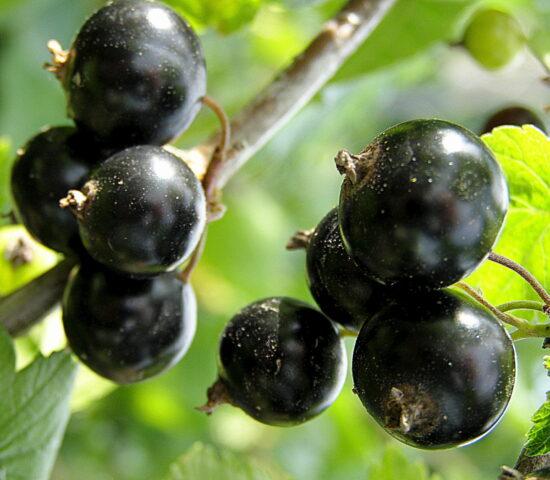
Galinka currant is recommended for preparation of preparations for the winter, jam, pastille, wine
Characteristics
According to the description of the variety with photos and reviews, the black currant Galinka gives a good harvest of large berries. She has practically no shortcomings.
Drought tolerance, winter hardiness
Black currant Galinka is drought and frost resistant. The variety tolerates Siberian winters well when grown in the recommended regions. Heat resistance is high.
Pollination, flowering period and ripening times
Black currant Galinka is self-fertile, therefore it does not need pollinators. It is recommended to plant another 1-2 varieties of bushes nearby. This has a positive effect on yield and fruit size.
Galinka currant blooms in the second half of May. Its loose and drooping brushes have an average length, green axes. The flowers are glass-shaped, the color is pale pink. Their size is medium, the sepals are short. The stalks are thin and long. Ripening periods are average.
Productivity and fruiting, keeping quality of berries
Fruiting of the Galinka variety begins already in the second year after planting. One bush yields an average of 3.2 kg, maximum 4 kg of berries. On an industrial scale, 1 hectare of planting yields 11-13 tons. Such indicators are achieved when the bushes are 3-5 years old and the planting pattern is 3x1 m.
Galinka currant berries have a dry separation. They tolerate long-distance transportation well. Fruit keeping quality is low. With an average air humidity and 7-10 ° C, the harvested crop can be stored for up to two weeks. This period increases by 1.5 times at zero temperature.
Taste qualities
The berries of the black currant Galinka are sweet and sour. Their taste is good, his tasting score is four points. This variety has a pleasant aroma. The purpose of its fruits is universal. Blanks from them are rated higher in taste than fresh berries.
Disease and pest resistance
Galinka black currant has good immunity to powdery mildew, gall aphid. The variety is moderately susceptible to kidney mites and anthracnose, susceptible to septoria.
Advantages and disadvantages
Blackcurrant Galinka is good fresh, its taste is highly valued after processing. The maximum tasting score for the juice and compote from berries of this variety.
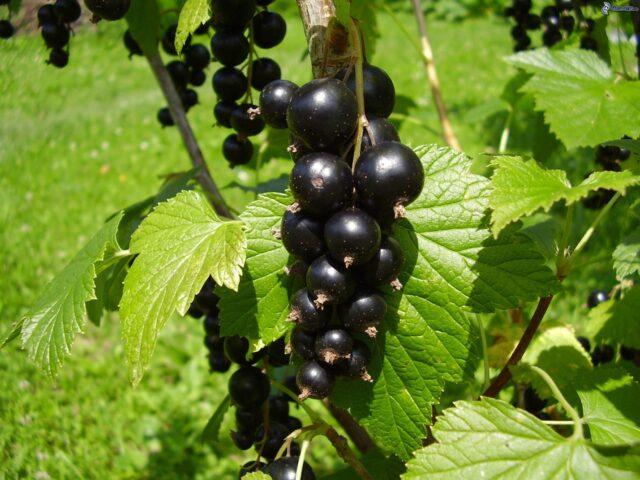
Galinka black currant berries ripen together
Pros:
- high productivity;
- versatility of fruits;
- self-pollination;
- good presentation;
- large berries;
- self-fertility;
- unpretentiousness to growing conditions;
- the possibility of long-distance transportation;
- immunity to powdery mildew, gall aphid;
Minuses:
- susceptibility to septoria.
Features of planting and care
Black currant Galinka can be planted in the spring before the start of sap flow or in the first half of October. If the root system is closed, then work can be planned throughout the growing season.
For the Galinka variety, open and well-lit areas are needed, protected from drafts. If the summer is hot and dry, then partial shade is better for the plant. Recommended acidity 5.5-7 pH, clay or loam soil. It should be loose and fertile, groundwater removed by at least 1-1.5 m.
For planting Galinka currants, 1-2-year-old seedlings with a long root system are better. What is important is the absence of damage and traces of rot, strong and flexible shoots with an even color and smooth bark.
The site must be prepared in advance - dig up, remove weeds and stones, add compost or humus. Make a planting hole with a side of 0.5 m. Leave from 1-2 m between the bushes. Add organic matter, ash and superphosphate to the removed fertile layer. Fill the hole halfway with this mixture, leave to shrink. Landing Algorithm:
- Place the seedling in the hole.
- Spread the roots.
- Cover the depression with earth.
- Compact the soil.
- Form a near-trunk circle, add 0.5 buckets of water.
- Mulch the soil.
- Run to cut into three buds.
Galinka black currant care:
- Water five times per season. Moisturizing is important during the formation of ovaries, the formation of fruits, after harvest. In a dry summer, watering every 1.5 weeks, four buckets per bush.
- Top dressing from 2-3 years. In the spring, humus, compost, 25 g of ammonium nitrate per 1 m², during flowering manure, potassium and superphosphate, after harvest - potassium-phosphorus fertilizers and humus.
- Mulching. In spring, lay out straw, compost or humus in a thick layer.
- Regular loosening, weeding.
- Pruning - after two years, leave the strongest and healthiest shoots, shortening by two buds. For the next season, leave six large branches, pinch the tops in the summer. In the fifth year, carry out anti-aging pruning, leaving four five-year, 1-2- and 3-year-old shoots.
Preparation of Galinka currants for winter consists in abundant watering and mulching. Shelter is not required, protection from rodents is needed - mesh, roofing material. If there is not enough snow, then it should be shoveled to the bushes and covered with snow.
Galinka currant can be affected by septoria. It manifests itself in dark brown spots on the leaves, which then turn white with the exception of the edges. The greens dries, falls off. Fungicides help:
- copper sulfate;
- Oxyhom;
- Abiga Peak.
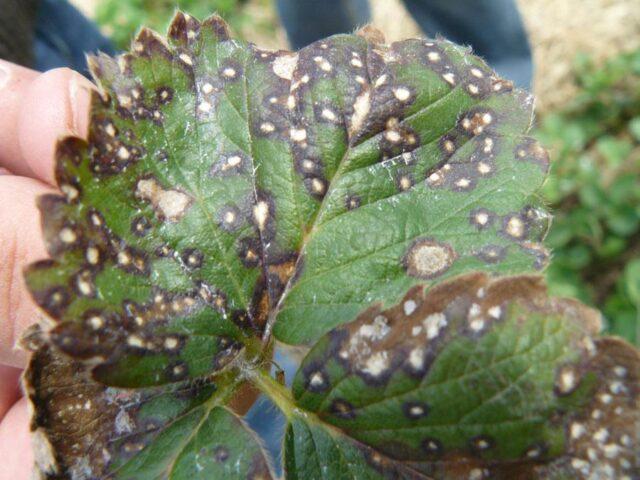
Due to septoria, yield decreases
Another fungal infection is rust. It is expressed by orange pads on the backs, yellowing of the front sides of the leaves. Fungicides are also needed to fight.
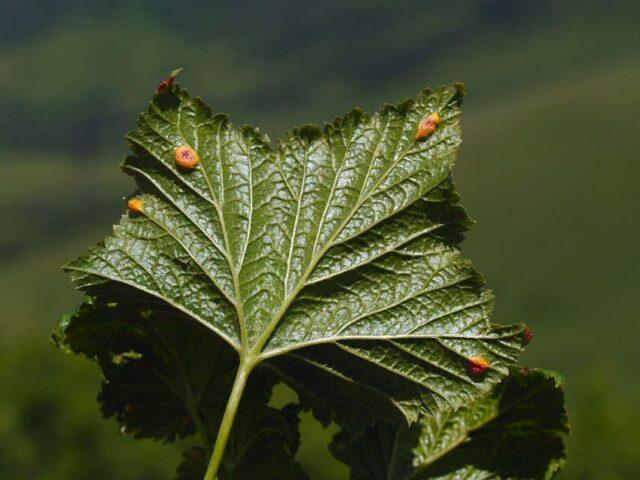
Without treatment, rust affects berries that are no longer suitable for food.
Conclusion
Black currant Galinka is an unpretentious variety of domestic selection. It is resistant to frost and drought, tolerates heat well, and is not afraid of many diseases and pests. This variety has a good yield, large berries for universal use. The main disadvantage is susceptibility to septoria.
Reviews with a photo about the variety of black currant Galinka

